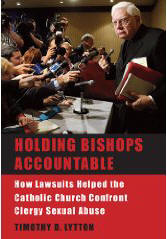|
 Just
when I think I have read the final word on the clergy child abuse
crisis an important book pops up that focuses on a new facet of the
whole ordeal. What a great job law professor Tim Lytton has done to
explain part—an important part—of the response to the crisis that
confuses many lay folk (and some lawyers); the persuasive value of
the tort system. Just
when I think I have read the final word on the clergy child abuse
crisis an important book pops up that focuses on a new facet of the
whole ordeal. What a great job law professor Tim Lytton has done to
explain part—an important part—of the response to the crisis that
confuses many lay folk (and some lawyers); the persuasive value of
the tort system.
In
1988 I reviewed 1,800 letters and reports from men and women who
alleged that they had been sexually abused by a Catholic priest,
bishop, or member of a Catholic religious order. Not one—not a
single person—was asking for money. What they were seeking was
recognition of their suffering, validation of the facts in their
case, and belief in their word against a powerful person and
structure that denied, defied, and at times humiliated and abused
them further. An apology would have been comforting and healing.
Their pleas were not heard.
Timothy Lytton’s title says it all—how lawsuits helped the Catholic
Church. What some people think is only a money-driven effort is
rightly exposed in the sex abuse crisis as fundamentally a
reform-driven tool. I was a consultant on a number of cases where
the victim asked for modest sums to finish their education only to
be denied. When the case was litigated the plaintiff was awarded
several millions of dollars. The victim then was in a position to
demand conditions to assist other victims.
Lawyers of experience know the value of the tort system in the
clergy abuse crisis. Jeff Anderson, one of the leaders in attacking
the problem 25 years ago, says trenchantly, “Never before has the
American tort system played such an influential role in educating
the public and encouraging massive change in the way children are
protected.”
The
appeal to lawyers and the law for protection was the last, not the
first, resort for most victims. Luckily some of the abused teamed
up with committed lawyers to head the drive toward responsible
recognition and an honest response from church authority. The fight
is still not easy. The resistance from bishops and cardinals has
proved truly Machiavellian—still. That is one of the reasons anyone
who wants to understand Catholic clergy sex abuse needs to read this
book.
There
is no question that the victims’ movements, their cases brought to
civil (and criminal) litigation, and media accounts blasted into
public attention were the driving forces that has resulted in
whatever positive movement Catholic authorities have taken.
All
church action has been reactive; this includes Pope Benedict’s
remarks during his six day U.S. tour in April 2008. There is still
no clear, moral, and independent leadership from within the Catholic
Church moving it toward full transparency and accountability. But
the tort system has held institutional ‘feet to the fire’ by
exposing pleadings, depositions, and documents (and grand jury
reports) that extricated a refined “confession” of an institution in
moral meltdown.
In
1992 Father Stephen Rossetti (now head of St. Luke Institute) told a
group of Fr. James Porter's victims "The church will not change
until it is faced with bankruptcy." That was in response to their
question, "what will it take to make the church change."
Hugh
payments have caught the church’s attention, but the bishops
continue to resist basic reforms even under the pressure of
threatened bankruptcy.
Money
is an issue; for the church that is a renewal resource. But the
pressure of the tort system that will continue to hold bishops
accountable for their behavior, that of priests, and employees holds
continued promise of eventual inevitable reform of a system co opted
by its dedication to image and secrecy.
Lytton
has done all of us who care about the protection of children a big
service by explaining the process of tort litigation and its power
to influence institutional performance and policy.
The
Web Page for the book is:
www.albanylaw.edu/lytton
|